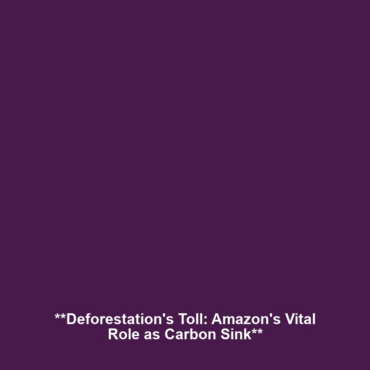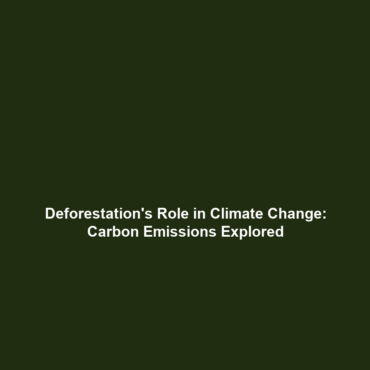The Impact of Deforestation on the Amazon’s Role as a Carbon Sink and Global Climate Regulator
Introduction
The Amazon rainforest plays a critical role in regulating the Earth’s climate and acting as a crucial carbon sink, absorbing significant amounts of carbon dioxide. However, rampant deforestation poses a severe threat to its ability to perform these essential functions. Understanding the impact of deforestation on the Amazon’s carbon storage capabilities is vital for addressing broader issues of biodiversity loss and climate change. This article delves into the intricate connection between deforestation in the Amazon and its implications for global climate regulation.
Key Concepts
Deforestation and Carbon Sequestration
Deforestation refers to the large-scale removal of trees, significantly affecting the Amazon’s capacity to sequester carbon. The major concepts related to this topic include:
- Carbon Sink: The Amazon rainforest serves as one of the planet’s largest carbon sinks, absorbing about 2 billion tons of CO2 annually.
- Biodiversity Loss: Deforestation threatens countless species, disrupting ecosystems and reducing biodiversity.
- Climate Regulation: The loss of trees diminishes the rainforest’s ability to regulate local and global climates by affecting rainfall patterns and temperature.
Applications and Real-World Uses
The impact of deforestation on the Amazon’s role as a carbon sink has substantial real-world applications:
- Climate Policy: Understanding how deforestation impacts carbon emissions helps shape effective climate policies and conservation strategies.
- Sustainable Practices: Implementing sustainable forestry can help minimize the impact on carbon storage and biodiversity, essential in mitigating climate change effects.
- Carbon Trading: Initiatives for carbon credits rely on accurate assessments of how deforestation affects carbon sinks.
Current Challenges
There are several challenges related to analyzing the impact of deforestation on the Amazon’s carbon dynamics:
- Data Deficiency: Limited data about tree species diversity and their carbon-sequestration abilities can hinder effective analysis.
- Illegal Deforestation: Unregulated logging activities complicate efforts to monitor and mitigate deforestation.
- Climate Change: Altered weather patterns can affect the rainforest’s health and carbon sequestration capability.
Future Research and Innovations
Future research and technological innovations will be crucial for understanding and addressing the impact of deforestation on the Amazon:
- Remote Sensing: Advancements in satellite technology can provide better monitoring of deforestation rates and carbon emissions.
- Genetic Studies: Research on tree genetics could lead to the development of more resilient species that can thrive in changing environments.
- Carbon Capture Technologies: Innovations aimed at enhancing carbon capture in forest ecosystems can mitigate the impact of deforestation.
Conclusion
In summary, the impact of deforestation on the Amazon’s role as a carbon sink significantly affects global climate regulation and biodiversity. Urgent action is required to address these challenges through sustainable practices, comprehensive policies, and innovative research. For additional insights on related topics, consider exploring our articles on biodiversity loss and sustainable forestry practices.

